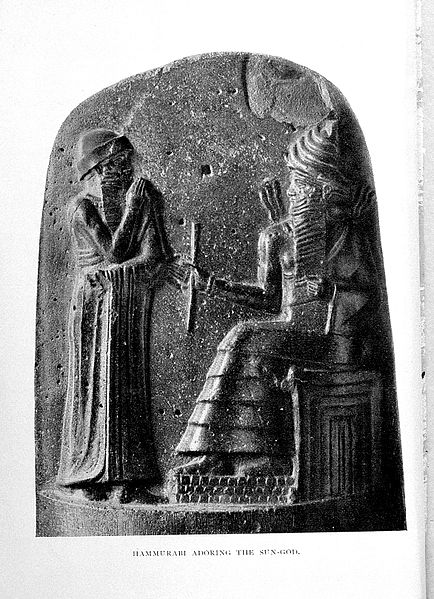Table of Contents |
This lesson explores two different empires, separated by about 800 years. The Akkadian Empire was founded around 2300 BC and dissolved around 2150 BC; the Assyrian Empire rose to power around 1300 BC and dissolved around 612 BC.
The timeline below highlights the reigns of these two empires. Note the arrow that indicates the beginning of the Roman Republic as a northern reference point. The Akkadian Empire is highlighted in purple, and the Assyrian Empire is highlighted in orange.

In addition to the Akkadian and Assyrian empires, you will learn about the Babylonian Empire.
At one point or another, each of these empires was the dominant force of its day, ruling over most of Mesopotamia. Take a look below to see the origins of Syria in the north and Babylonia in the south.

The lamassu was important to these empires. A representation of an important guardian deity of Sumerian origin, the lamassu was a potpourri of animal bits and pieces. It typically featured the head of a human, the body of a lion or bull, and the wings of an eagle.
EXAMPLE
Below is a relief figure of the lamassu from the palace of Sargon II, who was an Assyrian king, not to be confused with Sargon of Akkad.
In the image above, you can see the body of a bull, the human head, and the wings of an eagle. Note the use of twisted perspective—the head is facing the viewer, while the body is in profile.
Lamassu can be seen throughout the remains of Sargon II’s palace, and are thought to serve as protective figures, like eternal guardians made of stone.
The hieratic scale, frequently used throughout ancient Mesopotamian art, refers to the use of relative size to show relative importance. The larger the figure, the more important it is.
IN CONTEXT
Here is an example of the hieratic scale:

If you were looking at these three figures as a part of the same composition, the larger figure, such as a deity or king, would be most important. The next largest would be someone of importance, but less so relative to the larger figures, such as the son and heir of the king. The smaller figures would be people with the least amount of importance, perhaps enemies of the king or his slaves or servants.
Yet another example of the hieratic scale in action is the Stele of Naram-sin. Naram-sin was the grandson of Sargon of Akkad. A stele is a slab of stone or terra-cotta. It was used as a tool for communication, as well as a commemoration of an important event, such as the victory of an important battle.
EXAMPLE
Pictured here is Naram-sin’s conquest of the Lullubi people from Eastern Mesopotamia.
Notice in the above image that Naram-sin is the most important figure in the composition and, therefore, the largest figure. Some of his crew or soldiers can be seen directly beneath him, and they are the next largest figures in the composition. The smallest figures are the enemies of Naram-sin, such as the gentleman with a spear through his throat.
As far as the importance of art and architecture as a means of demonstrating authority, there is another very important aspect of the stele. These rays of light here are thought to represent deities that were important to the Akkadians. Conquest under the careful observance and consent of a deity would serve to reinforce the legitimacy of Naram-sin’s rule.
EXAMPLE
Here is the Stele of Hammurabi, named after the first king of the Babylonian Empire, Hammurabi.
This stele (above) depicts two important things. First, we see Hammurabi on the left receiving the law or code of conduct for the Babylonian people from the god Shamash. This depiction serves to legitimize Hammurabi’s code, which is inscribed below him. In addition to being an example of authority and legitimacy for Hammurabi, it also serves as a means of communicating the law to his citizens.
EXAMPLE
This next example is a bust of an Akkadian ruler, likely Sargon of Akkad, aka Sargon the Great.
This highly stylized bronze casting was once attached to a body, which is now lost. It was most likely a representation of royalty and authority instead of the actual appearance of Sargon himself. Portraying someone in an idealized form was a way of impressing observers and reinforcing a ruler’s authority. The damage to the eye is thought to be intentional as a way of destroying the power of the image.
The rooms in two palaces of ancient Akkadia and Assyria were decorated with reliefs depicting manly scenes, such as hunting and battle. These reliefs had two jobs:

~645 BC
Relief carving on alabaster (stone)
The lioness is shown pierced with three arrows, dragging her legs, and moaning in pain. Not only would the slaughter of dangerous and powerful animals raise credibility in the eyes of others, but this action probably served as a source of entertainment for the viewers as well. This particular relief is from the palace of Ashurbanipal, the last King of the Assyrian Empire in Ancient Nineveh in northern Iraq.
Scenes of battle with the home team winning, of course, were another popular subject for palace reliefs. Powerful rulers had powerful armies, after all. Rulers wanted to ensure that this was ingrained in the hearts and minds of their subjects and opponents.
Take a look at this particular scene from the palace of Ashurbanipal in the ancient city of Nimrud, near the ancient city of Nineveh, and more north of the modern-day city of Baghdad. It depicts archers firing upon enemies from behind the protective shield of another soldier.

~883-859 BC
Relief carving from Central Palace in Nimrud
Source: THIS TUTORIAL WAS AUTHORED BY IAN MCCONNELL FOR SOPHIA LEARNING. Please see our Terms of Use.